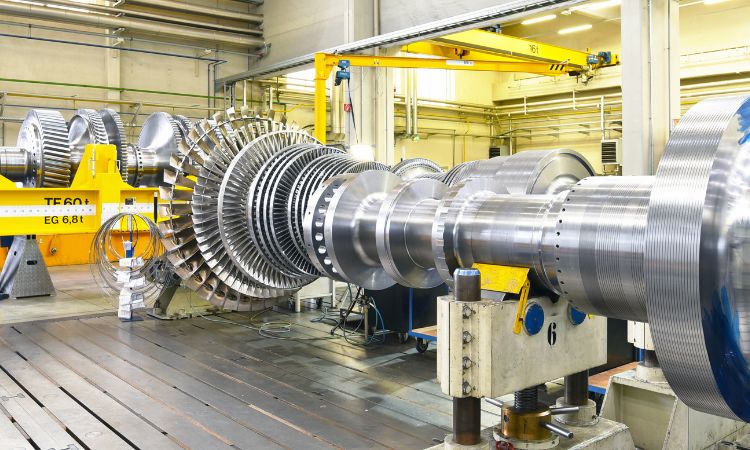The Role of Industrial Gas Turbines in Power Generation
The global industrial gas turbine market size reached a value of about USD 20.83 billion in 2021. The market is expected to grow at a CAGR of about 3.5% during the forecast period 2024-2032. In an era where energy demand continues to rise and environmental concerns are paramount, industrial gas turbines have emerged as a key player in the power generation landscape. These versatile machines have revolutionized the way we produce electricity, providing a range of benefits that go beyond their efficiency and reliability. This blog post will delve deep into the world of industrial gas turbines, shedding light on their working principles, applications, environmental impact, and the role they play in shaping the future of power generation.
Understanding Industrial Gas Turbines
Industrial gas turbines, also known as combustion turbines, are a type of internal combustion engine. Unlike traditional reciprocating engines, gas turbines operate on an open Brayton cycle, which allows for continuous combustion and exhaust. This fundamental difference gives them unique advantages in power generation.
At their core, gas turbines consist of several key components:
-
Compressor: Gas turbines start the process by compressing incoming air. This compression raises the air pressure, making it suitable for combustion.
-
Combustion Chamber: Here, fuel is mixed with the compressed air and ignited, producing a high-temperature, high-pressure gas flow.
-
Turbine: The hot gas is then directed through a series of turbine blades, causing them to spin. This mechanical energy is what drives the generator to produce electricity.
-
Exhaust: The exhaust gases exit the turbine, and some systems may incorporate additional components to recover waste heat for various purposes, improving overall efficiency.
Types of Power Plants Using Gas Turbines
Industrial gas turbines find application in various types of power plants, each with its own advantages and use cases:
-
Simple-Cycle Gas Turbine Plants: These power plants consist solely of a gas turbine and a generator. They are known for their rapid startup, making them suitable for meeting sudden spikes in electricity demand, such as during peak hours.
-
Combined-Cycle Gas Turbine (CCGT) Plants: In a CCGT plant, gas turbines are used in combination with steam turbines. The exhaust heat from the gas turbine is captured to produce steam, which drives a secondary steam turbine. This combined-cycle approach significantly improves overall efficiency, making CCGT plants a popular choice for base-load power generation.
-
Cogeneration (CHP) Plants: Some gas turbine power plants are designed for cogeneration, where both electricity and useful heat are generated simultaneously. This is particularly valuable in industrial settings, where the waste heat can be used for processes like district heating or industrial heating.
-
Aero-Derivative Gas Turbines: Originally designed for aircraft, these turbines have found application in power generation. They are compact and lightweight, making them suitable for mobile power plants and decentralized energy generation.
Advantages of Industrial Gas Turbines in Power Generation
The adoption of industrial gas turbines in power generation is driven by several compelling advantages:
-
Efficiency: Gas turbines are known for their high thermal efficiency, particularly in combined-cycle configurations. They can achieve efficiencies exceeding 60%, making them a cost-effective choice for power generation.
-
Fast Startup: Gas turbines can start generating power in a matter of minutes, making them ideal for meeting sudden surges in demand or serving as backup power sources.
-
Fuel Flexibility: Industrial gas turbines can run on a variety of fuels, including natural gas, diesel, and even renewable fuels like biogas or hydrogen, enhancing energy security and reducing environmental impact.
-
Reduced Emissions: Gas turbines are relatively clean-burning, producing fewer greenhouse gas emissions and pollutants compared to other fossil fuel-based power generation methods.
-
Grid Stability: Their ability to respond quickly to changes in load and provide grid stability makes gas turbines essential in maintaining a reliable power supply.
Environmental Considerations
In an era where climate change and environmental sustainability are top concerns, the environmental impact of power generation technologies is critical. Industrial gas turbines have made significant strides in reducing their environmental footprint:
-
Emissions Reduction Technologies: Gas turbine manufacturers have invested in emissions reduction technologies, including advanced combustion techniques, selective catalytic reduction (SCR), and dry low NOx (DLN) combustors, to minimize nitrogen oxide (NOx) emissions.
-
Carbon Capture and Utilization (CCU): Research and development efforts are ongoing to explore the feasibility of integrating carbon capture technologies with gas turbine power plants, reducing carbon dioxide (CO2) emissions.
-
Hydrogen Integration: The shift towards green hydrogen as a fuel source holds promise for further reducing emissions in gas turbine power generation.
Case Studies and Success Stories
Let’s take a look at a few case studies that demonstrate the impact and versatility of industrial gas turbines in power generation:
Case Study 1: The Istanbul Power Plant In Istanbul, Turkey, the Samsun CCGT power plant is a testament to the efficiency of combined-cycle gas turbines. The plant’s use of natural gas and a Siemens H-class gas turbine has helped meet the city’s growing electricity needs while reducing emissions.
Case Study 2: Mobile Gas Turbines in Australia Australia’s Northern Territory faces challenges in supplying power to remote areas. Mobile gas turbines have been deployed to generate electricity in these regions, ensuring a reliable power supply for communities off the grid.
Case Study 3: Cogeneration at a Hospital Hospitals require a consistent and reliable power supply. Cogeneration plants with gas turbines are used in healthcare facilities worldwide to provide both electricity and steam for heating and sterilization.
These case studies showcase the adaptability of gas turbines in diverse settings, from urban power plants to remote regions and critical healthcare facilities.
Future Trends and Innovations
As we look toward the future, several trends and innovations are shaping the industrial gas turbine industry:
-
Hydrogen-Fueled Turbines: The integration of green hydrogen as a fuel source holds the potential to further reduce emissions in gas turbine power generation.
-
Digitalization and IoT: The use of digital twin technology and the Internet of Things (IoT) is enhancing the monitoring, maintenance, and efficiency of gas turbine systems.
-
Advanced Materials: Ongoing research into high-temperature materials is enabling the development of more efficient and durable gas turbine components.
-
Decentralized Energy: The deployment of small-scale gas turbines for decentralized energy generation is becoming more common, allowing communities and industries to be less reliant on centralized power plants.
-
Microturbines: These small gas turbines are finding applications in distributed energy generation and combined heat and power (CHP) systems for residential and small-scale commercial use.
Challenges and Considerations
While industrial gas turbines offer numerous advantages, there are also challenges and considerations to be mindful of:
-
Fuel Availability: The availability and cost of fuel, especially in remote areas, can affect the feasibility of gas turbine power generation.
-
Maintenance: Gas turbines require regular maintenance to ensure their reliability and efficiency. Downtime for maintenance can impact power generation.
-
Environmental Regulations: Compliance with environmental regulations, particularly emissions limits, is crucial for gas turbine operators.
-
Initial Capital Costs: The upfront costs of gas turbine power plants can be substantial, although they are often offset by long-term operational savings.
Conclusion
The global industrial gas turbine market is on an upward trajectory, driven by the need for efficient and reliable power generation solutions. These machines have proven their worth in a variety of applications, from providing backup power during peak demand to serving as the backbone of large-scale power plants. Their ability to adapt to changing energy landscapes, reduce emissions, and contribute to grid stability positions them as a vital component of the future of power generation.
As technology continues to advance, we can expect even greater efficiency gains, reduced environmental impact, and increased fuel flexibility in the industrial gas turbine industry. Whether powering cities, remote communities, or critical facilities, industrial gas turbines are at the forefront of modern energy solutions, helping to meet the world’s growing demand for electricity while mitigating the environmental challenges of our time.



